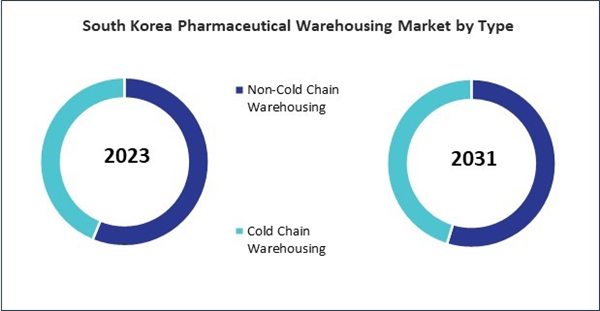The China market dominated the Asia Pacific Pharmaceutical Warehousing Market by Country in 2023, and would continue to be a dominant market till 2031; thereby, achieving a market value of$3.67 billion by 2031. The Japan market is registering a CAGR of 4.2% during (2024 - 2031). Additionally, The India market would showcase a CAGR of 5.6% during (2024 - 2031).
Compliance with stringent regulations governing the pharmaceutical industry is paramount for pharmaceutical warehouses. These facilities adhere to strict standards regarding storage conditions, documentation, and security protocols to ensure product safety and efficacy.
Moreover, by maintaining meticulous records and implementing robust quality control measures, warehouses help pharmaceutical companies and healthcare providers navigate regulatory requirements and uphold the highest compliance standards.
China's government has been actively promoting the development of its pharmaceutical industry through various policies and initiatives. For example, the "Made in China 2025" plan seeks to position China as a manufacturing leader in high-tech sectors, such as medicine. Government support and incentives for pharmaceutical companies encourage investment in manufacturing facilities and distribution networks, driving the demand for it.
Based on Type, the market is segmented into Non-Cold Chain Warehousing, and Cold Chain Warehousing. Based on Application, the market is segmented into Pharmaceutical Factory, Pharmacy, Hospital, and Others. Based on countries, the market is segmented into China, Japan, India, South Korea, Singapore, Malaysia, and Rest of Asia Pacific.
List of Key Companies Profiled
- Univar Solutions, Inc.
- Brenntag SE
- Odyssey Logistics & Technology Corporation (The Jordan Company)
- Rinchem Company, LLC (Stonepeak)
- Anchor 3PL.
- Broekman Logistics
- Commonwealth Inc.
- DHL GROUP
- RSA TALKE
- KEMITO
Market Report Segmentation
By Type
- Non-Cold Chain Warehousing
- Cold Chain Warehousing
By Application
- Pharmaceutical Factory
- Pharmacy
- Hospital
- Others
By Country
- China
- Japan
- India
- South Korea
- Singapore
- Malaysia
- Rest of Asia Pacific
Table of Contents
Companies Mentioned
- Univar Solutions, Inc.
- Brenntag SE
- Odyssey Logistics & Technology Corporation (The Jordan Company)
- Rinchem Company, LLC (Stonepeak)
- Anchor 3PL.
- Broekman Logistics
- Commonwealth Inc.
- DHL GROUP
- RSA TALKE
- KEMITO
Methodology

LOADING...









